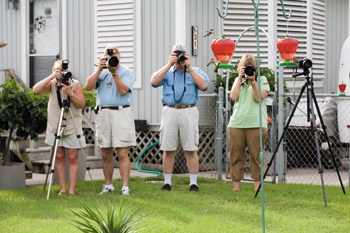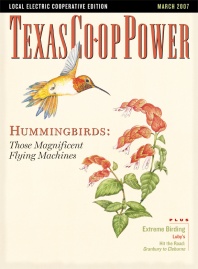Exploding from the oak tree with a stream of chatter, a ruby-throated hummingbird streaked toward his rival now perilously close to the treasured feeder. The two hummingbirds had clashed many times this morning, and neither was about to give up the precious resource without a fight. Swooping across the garden, the two birds chattered, chirped and whistled before separating and returning to their perches.
This scene is repeated several times each hour at feeders all across the United States, while in the yard right next door there might be a hummingbird feeder that is woefully ignored by the quarreling birds. What makes one feeder attractive while the other is ignored? Habitat, say the experts at the Texas Parks and Wildlife Department. That means shelter, water and food.
The typical suburban lawn with its carefully tended carpet of grass, suitable for playing croquet, won’t hack it. Birds need small trees or bushes for shelter, observation and nesting. Frequently, the scrub vegetation cleared for new homes is prime hummingbird real estate. Of course, all rules are made to be broken. According to TPWD, hummingbirds have made themselves at home on overhead wires, antenna arms, feeder hooks and clotheslines, but given a choice, the hummers will usually perch in a tree or a bush. If at all possible, it’s good to have some shade-loving nectar plants such as columbine or Turk’s cap beneath the shelter.
A shallow source of clean water is the next necessity. A regular birdbath can be modified with rocks to provide the quarter-inch of water a hummingbird needs. The little creatures adore running, misting or dripping water. It is great fun to watch them burst out of the trees to dip their iridescent wings in a water feature made to fit their needs.
Hummingbirds will feed on small insects and bugs, but mainly they are attracted to red-hued nectar plants (see plant list). Flowering shrubs and plants that bear nectar give the bonus of being attractive, but the most basic plastic hummingbird feeder works fine. Make sure it has a perch so the little fellows don’t have to consume precious energy hovering while they eat. The feeder should have red highlights, but adding red coloration to the nectar mixture is unnecessary and may be dangerous. Don’t fall for the fancy, exotic feeders. Keep it simple, many speakers at the Hummer/Bird Celebration emphasized.
The usual feeding mixture is 4 parts boiled water to 1 part sugar. Feeders should be emptied, cleaned and refilled regularly—every two to four days in warm weather and every four to six days in cool weather.
Once you’ve established a desirable hummingbird habitat, there may be a problem with males challenging one another at the feeder. The answer is to place more than one feeder in your yard, providing distance between them.
Caution: Don’t place brightly colored artificial flowers in your garden because hummingbirds will waste precious energy futilely trying to feed at them. Cemeteries are a hazard for the birds because of the artificial arrangements. A hummingbird can use up a day’s stored energy searching a cemetery in vain. Sometimes a creature will perish before it finds a genuine source of nourishment.


